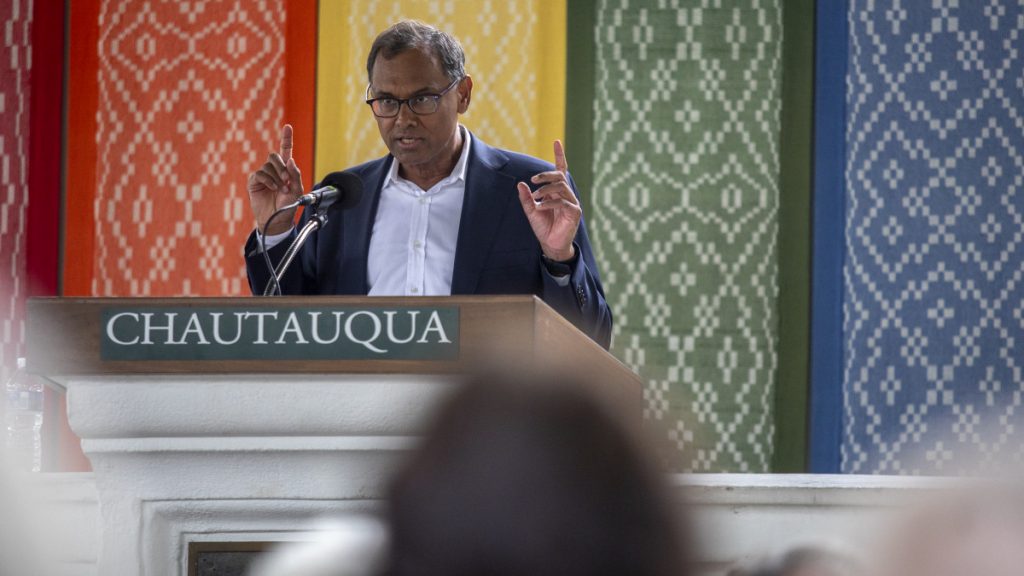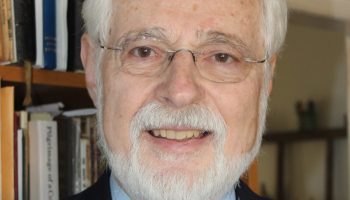In the United States, one in five deaths are caused by heart disease, and one person dies every 34 seconds from cardiovascular disease, according to the CDC. While these complications with the heart are normally blamed on physical, biological factors, cardiologist Sandeep Jauhar argues one’s mental state affects the heart more than one would imagine.
Jauhar, a practicing cardiologist and the author of Heart: A History, introduced Week Seven’s Interfaith Lecture Series theme of “Home: A Place for Human Thriving” on Monday, Aug. 8 in the Hall of Philosophy. In his lecture, “The Emotional Heart,” Jauhar used his expertise and research in the field of cardiology to explain how emotions not only affect heart health, but how they have the power to actually shape the heart.
Drawing on a study conducted in the small town of Framingham, Massachusetts, in the 1940s, Jauhar said much of what is known about heart disease was born from this study.
At that time, cardiovascular heart disease accounted for nearly half of all deaths in the United States, and the Framingham study aimed to discover why. Even though the study originally considered emotional and mental states as potential risk factors, it shifted focus toward biological risk factors rather than psychological.
“Questions about sexual dysfunction, psychiatric problems, emotional stress, income and social class were discarded. As one researcher put it, the Framingham study as it emerged in the 1950s had ‘little interest in investigating psychosomatic, constitutional or sociological determinants of heart disease,’ ” Jauhar said. “This would turn out to be a major flaw.”

Key findings of this study, and others around the 1960s, found that high blood pressure, hypertension, diabetes, high cholesterol and smoking were all risk factors of cardiovascular heart disease. Later, a 12-year study of approximately 20,000 Swedish men found that four out of five heart attacks could be prevented through Framingham-inspired lifestyle changes.
“But as important as the Framingham Heart Study has been in advancing our understanding of coronary heart disease, it does not tell the whole story,” Jauhar said. “My talk today will focus on these (psychological) factors, on what one might call the emotional heart.”
Throughout history, the heart has been used as a symbol of romantic love and other intense emotional states. In the past, people believed the heart served as the home for love.
“Today, we know that the heart is not the source of love or the other emotions, per se. … Yet more and more, we’ve come to understand that the connection between the heart and the emotions is a highly intimate one,” Jauhar said. “The heart does not originate our feelings, but it is highly responsive to them.”
Strong, negative emotions, such as fear and grief, have the potential to cause profound cardiac injury. Intense stress, Jauhar said, can change the speed of a heartbeat due to a maladaptive fight or flight response. These signals tell the blood vessels to constrict and blood pressure to rise, which can cause damage.
Takotsubo cardiomyopathy, also known as broken heart syndrome, is another example of how intrinsically linked the heart is to emotional distress. This syndrome is caused by extreme stress or grief, which acutely damages the heart.
The shape of the left ventricle actually changes, taking the shape of the takotsubo octopus trap, from which the name of the disease is derived. Often, this syndrome resolves within a few weeks, but during its peak, it can result in heart failure.
Causes of broken heart syndrome vary beyond cases of extreme grief and stress, as Jauhar explained that public speaking, gambling losses, domestic disputes and even surprise birthday parties have caused this syndrome to develop.
There are also examples of widespread outbreaks of this syndrome, which have occurred after shared traumatizing situations like natural disasters.
“In 2004, a major earthquake devastated the district on the largest island in Japan. Thirty-nine people were killed and more than 3,000 were injured,” Jauhar said. “… Researchers found that there was a 24-fold increase in the number of broken heart syndrome cases in the district one month after the earthquake, compared with a similar period the year before.”
Finding that most of these patients lived near the epicenter of the catastrophe, Jauhar said this gives new meaning to the phrase “home is where the heart is.”
While other natural disasters have caused an uptick of takotsubo cardiomyopathy cases, research has found that populations less prepared to handle disasters experienced a higher risk of developing broken heart syndrome.
“We can acknowledge that even if our emotions are not located inside our hearts, the biological part overlaps its metaphorical counterpart in surprising and mysterious ways,” Jauhar said.
Jauhar detailed an incident of a prisoner who was made to believe he was being put to death by exsanguination. Jauhar said the prisoner was blindfolded and scratched, which made him believe he was truly bleeding. The study of this incident, from an Indian medical journal, explained that large vases filled with water were even set up to mimic the sound of dripping blood.
“Finally, the silence was absolute, as the dripping of water ceased. Although the prisoner was a healthy young man, at the completion of the experiment when the water flow stopped, he appeared to have fainted,” Jauhar said. “On examination, however, he was found to be dead, despite not having lost a single drop of blood.”
Describing this as an “emotional death,” Jauhar pointed to other similar incidents of fatality. The commonality of these deaths, according to Harvard physiologist Walter Cannon, is that the victims all believed they were defenseless against an external force that would cause their demise.
“This perceived lack of control, Cannon postulated, resulted in an unmitigated physiological response in which blood vessels constrict to such a degree that blood volume acutely dropped, blood pressure plummeted, the heart acutely weakened and massive organ damage resulted from a lack of transported oxygen,” Jauhar said.
Reinforcing the idea that broken hearts are literally and figuratively intertwined, Jauhar said that even animals experience this relationship.
The American Association for the Advancement of Science conducted a study published in their journal Science, in which researchers fed caged rabbits a high cholesterol diet. Half of the rabbits were given love and attention and were petted, and the study showed these rabbits had 60% less aortic disease than the rabbits that received no attention, even though both groups shared similar cholesterol levels, heart rate and blood pressure.
Japanese immigrants to America were the subject of another study, as coronary artery disease is relatively rare in Japan. However, Japanese immigrants’ rate of the disease doubled when they resettled in Hawaii and tripled when they relocated to the mainland. A study in the 1970s by Sir Michael Marmot and his colleagues at the University of California, Berkeley, School of Public Health found Japanese immigrants who continued to practice Japanese traditions had a much lower prevalence of heart disease, even when their levels of cholesterol and blood pressure matched Americans’ levels.
“The authors concluded that ‘retention of Japanese group relationships is associated with a lower rate of coronary heart disease,’ ” Jauhar said. “… Again, we see the importance of feeling at home in preventing heart disease. If cutting traditional cultural ties increases the risk of heart disease, then psychosocial factors must play a role in cardiovascular health.”
In American society, these factors present themselves in marginalized groups. Black Americans in poor urban areas have a much higher prevalence of hypertension and cardiovascular disease than other groups. While some have pointed to genetics, people in West Africa do not experience these high rates of heart issues.
Chronic arousal, or stress, appears to be the main cause, as prolonged periods with this stress cause hormonal releases of adrenaline and cortisol, which tighten blood vessels.
“These, in turn, lead to long-term changes, like arterial wall thickening and stiffening, that increase the blood pressure that the body tries to maintain,” Jauhar said.
Recent research has established a connection between negative affectivity traits, such as depression, anxiety and anger, to heart disease. The Lifestyle Heart Trial published in The Lancet in 1990, Jauhar said, found that “stress management was more strongly correlated with reversal of coronary artery disease than exercise.”
With these studies and others, Jauhar is confident that although these correlations do not prove causation, there are so many findings that exhibit the same patterns: Psychological health plays an important role in heart health. But he is concerned that modern scientific medicine may be at its limits when attempting to solve cardiovascular health issues.
“We will need to shift to a new paradigm, one focused on prevention (of heart disease) to continue to make the kind of progress to which we have become accustomed,” Jauhar said. “In this paradigm, psychosocial factors will need to be front and center in how we think about health problems.”
Calling for the realization that one’s home, family, job and mental state are deeply rooted in the heart, Jauhar believes psychosocial repair is necessary to treat the heart with love.
Posing the ideas of community-led initiatives to increase walking and biking rather than supporting sedentary lifestyles, or enhancing public life through conversation, Jauhar said there may not be a one-size-fits-all solution. These problems should be addressed on individual or community levels.
“It is increasingly clear that the biological heart is inextricably linked to its metaphorical counterparts,” Jauhar said. “Our mindset, our coping strategies, how we navigate challenging circumstances, our capacity to transcend distress — these things, I have learned, are also a matter of life and death.”




